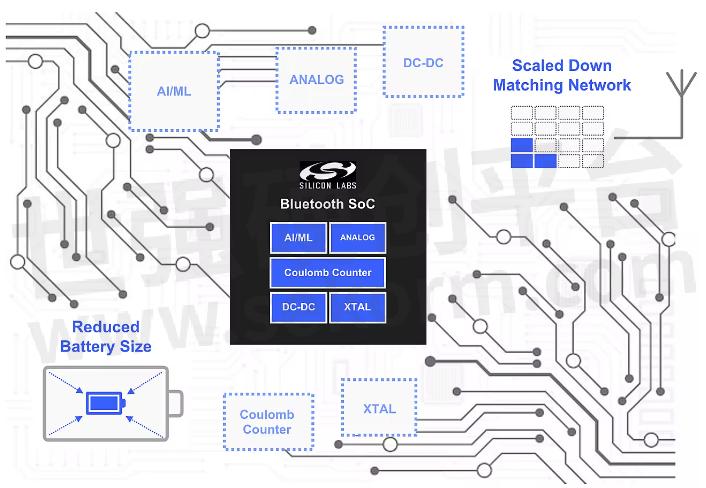How to Design Small Bluetooth Medical Devices and Wearables – Seven Design Concepts to Reduce Form Factor and Costs


Building Bluetooth medical devices with small and challenging form factors is not only about picking the smallest hardware components from the market. You can also reduce the size and dimensions of your product by optimizing the bill of materials (BoM). Using SILICON LABS’ integrated Bluetooth SoCs and modules that include various peripheral functions and features needed in medical applications can save you a great deal of PCB footprint, enhance design flexibility, and reduce costs.
Silicon Labs has been working with many medical device makers for decades. As a result of these successful engagements, Silicon Labs has developed several functionalities that are relevant to wireless medical applications and integrated them into Silicon Labs Bluetooth SoCs and modules. In this blog, Silicon Labs explains seven effective Bluetooth design concepts that can save your PCB footprint, design costs, and BoM on medical applications.
Silicon Labs’ Bluetooth solutions feature robust security with up to the highest PSA Level 3 Certification and DTSec, the Cybersecurity Standard for Connected Diabetes Devices.

The Seven Bluetooth Design Concepts
1. Integrated AI/ML Accelerator
Machine Learning (ML) allows large volumes of sensor data to be processed against existing models to identify irregularities and identify what data is required for transmission back to the cloud. For devices such as EKGs, wireless devices today transmit all of the collected data back to the cloud for processing and analysis. By identifying key data on the device, only certain subsets of data need to be transmitted back, saving precious resources and extending battery lifetime.
Artificial Intelligence (AI) can also be utilized in applications such as aging in place, where monitoring vitals, looking at changes in data, observing things like gait, and generally identifying patterns outside the norm can provide crucial diagnostic data to providers and trigger life-saving alerts to caretakers and loved ones that could drastically improve, and even save the life of a patient.
Silicon Labs BG24 Bluetooth SoC provides device makers with an integrated AI/ML accelerator with faster and more power-efficient ML inferencing, eliminating the need for an external ML processor on the board.
2. Analog Peripherals
An ADC is used on many wireless medical devices and wearables to enable sensor measurement and battery supply monitoring. Several Silicon Labs Bluetooth SoCs feature an integrated ADC with a high resolution of 12, 16, and 20 bits, saving costs, footprint, design, and testing effort. Additionally, Silicon Labs Bluetooth solutions deliver a higher effective number of bits (ENOB) for ADCs compared to many competing solutions, enabling more effective sampling.
For CGM manufacturers (and other portable medical devices) with solutions based on a discrete Analog Front End (AFE), the ADC and DAC are two critical functionalities that can be utilized on-chip, saving the need for additional components on the board. Silicon Labs BG24 features an ADC and DAC that can be coupled with external Operational Amplifiers to form a complete Analog Front End with reduced cost, space, and complexity of integration on a CGM device.
3. DC-DC Converter
A DC-DC converter is a valuable function for battery-powered medical devices. A Boost Converter allows an SoC to operate with lower-voltage batteries like alkaline and silver oxide with an input range of 0.8 to 1.7V, enabling a Bluetooth SoC to operate from the lower supply voltages. The Buck Converter allows an SoC to operate with other ~3V batteries, such as lithium coin cells, and it is used to improve energy efficiency and battery life or to reduce the size of a battery. The Silicon Labs BG27 includes both of these DC-DC Converters.
4. Coulomb Counter
To predict and prevent unexpected battery depletion during the use of critical health applications, a Coulomb Counter enables accurate battery level tracking to enhance user safety and experience. Silicon Labs BG27 features an integrated Coulomb Counter, eliminating the need for another external component on the board.
5. Low-Frequency RC Oscillator
For Bluetooth LE 2.4 GHz applications, the Bluetooth LE SoC needs to meet the specified Sleep Clock accuracy of ±500 ppm. BG22 and BG27 have an internal Low-Frequency RC oscillator 32kHz (LFRCO) that can self-calibrate against the HFXO on the device to meet the Bluetooth LE requirements. As a result, device makers can eliminate an external low-frequency crystal on the board, freeing up space and BoM costs unless the application requires a higher clock accuracy.
6. Matching Network
Silicon Labs reference radio board designs typically use an extensive number of components and multiple layers for RF and VDD filtering to provide device makers with the best possible RF performance at even the highest output power levels. However, medical devices and wearables use lower power levels, which means that you can decrease the number of PCB layers and elements from the design while maintaining an acceptable RF performance.
By optimizing the RF performance of BG22, BG24, and BG27 SoCs to match the ETSI and FCC regulations for low-power devices, you can reduce the number of bypass capacitors, filters, and the antenna matching network with a total of up to 6-14 components to decrease your footprint and BoM costs yet supporting the ETSI/FCC requirements.
7. Power Consumption
Minimizing the power consumption of a Bluetooth device enables device makers to achieve smaller device form factors. Ultra-low power consumption, both during operation and in optimized sleep modes (EM2), combined with the 1.5v supply through the DC-DC Boost provided in the BG27, allows a device to be fitted with an extremely small silver oxide 1.5v battery, minimizing the overall form factor of the device.
To learn more about the benefits of low power consumption, read the case study of the world's smallest wearable device, the smart tooth implant by Lura Health, which uses the Silicon Labs BG27 ultra-low-power Bluetooth WLCSP chip.
- |
- +1 赞 0
- 收藏
- 评论 0
本文由翊翊所思转载自SILICON LABS Blogs,原文标题为:How to Design Small Bluetooth Medical Devices and Wearables – Seven Design Concepts to Reduce Form Factor and Costs,本站所有转载文章系出于传递更多信息之目的,且明确注明来源,不希望被转载的媒体或个人可与我们联系,我们将立即进行删除处理。
相关推荐
【经验】如何把BG22工程移植为BG24工程
使用BG22平台,开发完成后,受限于资源不足或其它情况时,又不想更换一个芯片平台重新开发,增加工作量,这样的情况下可以直接使用BG24来做工程移植,不需要修改太多软件上的东西,简单移植即可。
The Complete Guide to Bluetooth Modules: Key Considerations For Choosing The Right Module For Project
In this comprehensive guide, we will explore everything you need to know about Bluetooth modules, including their functionality, types, applications, and key considerations for choosing the right module for your project.
Silicon Labs(芯科科技) 物联网无线产品选型指南
目录- Company and product overview Bluetooth Modules Bluetooth Modules Overview Bluetooth Modules Bluetooth Low Energy Kits Bluetooth Modules Blue Gecko Wireless Modules Bluetooth Modules Bluetooth Xpress Modules Bluetooth Modules Blue Gecko Wireless SoCs Bluetooth Modules Bluetooth BR/EDR Kits Bluetooth Modules Bluetooth BR/EDR Modules proprietary wireless devices proprietary wireless devices Proprietary Kits Proprietary Wireless Sub-GHz and 2.4 GHz Dual Band Devices Proprietary Wireless Sub-GHz Devices Wi-Fi Modules Wi-Fi Modules Wi-Fi Kits Mighty Gecko Modules Mighty Gecko Modules Mighty Gecko Development Kit Mighty Gecko Modules Mighty Gecko Mesh Networking Wireless SoCs Z-Wave Modules Z-Wave Modules Z-Wave Reference Designs Z-Wave Modules Z-Wave Development Kits
型号- EBWT41U,ZDB5202,SLEXP8027A,EFR32FG13P233F512GM48,EFR32™,SLWSTK6061B,MGM12P,EZR32WG,EFR32FG13P231F512GM32,EFR32BG12P232F1024GM68,EFR32MG13P733F512GM48,EFR32BG13P532F512GM32,WT12,AMW007-E04,EFR32,WT32I,EZR32™,BGM121,BGM11S,WT11U,EFR32FG,EFR32FG14P233F256GM48,SLWSTK6062B,RBK-ZW500DEV-CON2,SLWSTK6120A,SLWSTK6063B,RBK-ZW500,EFR32BG12P132F1024GL125,SI4XXX,ZM5101,ZM5304,ZDB5101,ACC-UZB3-U-BRG,BGM111,EBWT11U,EFR32FG14P233F128GM48,ACC-UZB3-U-STA,MGM111,ZDB5304,SLWSTK6000B,SLWSTK6020B,WT32,SI10XX,SLWSTK6101C,EFR32MG13P632F512GM32,AMW037,EFR32FG12P433F1024GM48,DKWT32I-A,EFR32MG12P132F1024GL125,EFR32MG1P133F256GM48,BGM13S,EZR32HG,BGM13P,BGX13P,EZR32LG,MGM13P,WT41U,EFR32BG13P733F512GM48,BGX13S,SLWSTK6060B,MGM13S,SLWSTK6065B,WGM110,RBK-ZW500DEV-EMB2,EFR32BG12P433F1024GL125,EBWT12-A,ZM5202,AMW007,SLTB004A,EFR32MG14P733F256GM48
选对了针对医疗和可穿戴设备的小型蓝牙芯片,设计毫不费力!
芯科科技一直为医疗设备和可穿戴设备制造商提供小型、专为应用而优化的蓝牙解决方案。以下展示了芯科科技提供的八款小型蓝牙芯片以及快速比较表,可以帮助您为应用程序选择最佳蓝牙解决方案!
深度探讨蓝牙6.0的未来发展趋势
在蓝牙6.0规范推出之际,Silicon Labs(芯科科技)就火速跟进,其强大的蓝牙产品组合和行业领先的蓝牙架构现已支持蓝牙6.0和蓝牙信道探测。芯科科技产品营销经理Aashish Chaddha近期并参与了EEWorld的专题访谈,来帮助工程师快速了解蓝牙6.0技术,并从产品层面彻底理解蓝牙6.0。
【选型】Silicon Labs BG22、xG24、BG27无线SoC比较及信驰达无线模块选型指南
作为安全、智能无线技术领域的前沿品牌,Silicon Labs在最近几年陆续推出了EFR32BG22、EFR32xG24、EFR32BG27等系列无线SoC。RF-star作为物联网行业领先的无线通信模组厂商,基于Silicon Labs的无线SoC推出了RF-BM-BG22x系列串口转蓝牙透传模块、RF-BM-BG24x旗舰系列低功耗蓝牙模块和RF-BM-MG24x旗舰系列并发多协议无线模块。
芯科科技提供多款无线连接和控制芯片产品及解决方案,BG2x系列蓝牙SoC成就多样医疗物联网用例,
Silicon Labs(亦称“芯科科技”)的无线SoC和MCU助力全球客户的医疗物联网应用创新,持续打造更智能、高效、安全和便捷的健康监测设备。智能和网联技术近年来一直是医疗和健康保障领域内的热门技术,许多厂商都在利用医疗物联网(IoMT)技术开发更加智能和互联的健康监测设备,以利用物联网、云计算、人工智能和可穿戴等新一代信息通信技术,来帮助用户时刻监控自己的健康状况、降低医疗费用和就医麻烦。
智能设备设计概念并开发小型医疗、可穿戴和娱乐设备
随着科技的发展,电子产品的体积越来越小,并被赋予更多智能功能,与网络连接也成为基本功能,像是小型蓝牙医疗保健设备与可穿戴设备、智能娱乐设备和增强现实(AR)和虚拟现实(VR)解决方案等产品,已经逐步改变人类的生活样貌。本文将为您介绍设计这类电子产品的设计概念,以及由Silicon Labs(芯科科技)所推出相关解决方案的产品特性。
洞悉标准化蓝牙ESL应用潜力,芯科科技全系列低功耗、高性能蓝牙SoC和模块现已支持最新蓝牙5.4版本
随着蓝牙标准的推陈出新,Silicon Labs(亦称“芯科科技”)也持续升级蓝牙解决方案,全系列低功耗、高性能蓝牙SoC和模块现已支持最新蓝牙5.4版本,以满足开发人员的需求。
芯科科技BG2x系列蓝牙SoC引领可穿戴设备创新,打造AI健康生活新纪元
随着人们对个人健康和智能生活的追求不断升温,可穿戴设备市场呈现出蓬勃发展的态势。在这个充满机遇与挑战的领域,Silicon Labs(亦称“芯科科技”)凭借其深厚的技术积累和敏锐的市场洞察,成为了行业的佼佼者。近日,芯科科技的家居和生活业务部可穿戴和生活业务经理Pranay Dixit参与了EEPW电子产品世界的访谈,就可穿戴设备市场的现状、公司战略以及技术创新等方面进行了深入探讨。
RF-star Launches Bluetooth UART Protocol for CC2652P High-Power BLE Modules RF-BM-2652P2/P2I
RF-star has released its latest Bluetooth UART transparent transmission protocol for CC2652P-based BLE modules RF-BM-2652P2 and RF-BM-2652P2I. This new offering is set to revolutionize the landscape of high-power Bluetooth Low Energy (BLE) modules, by providing developers with robust, long-range wireless solutions tailored for multi-connectivity needs.
Silicon Labs Announces New Bluetooth® Location Services with Advanced Hardware and Software
Silicon Labs announced its new, Bluetooth Location Services solution using accurate, low-power Bluetooth devices to simplify Angle of Arrival (AoA) and Angle of Departure (AoD) location services.
芯科科技支援新的蓝牙®网状网络功能增强和网络照明控制标准化配置文件
中国,北京 - 2023年9月21日 – 致力于以安全、智能无线连接技术,建立更互联世界的全球领导厂商Silicon Labs(亦称“芯科科技”,NASDAQ:SLAB),今日宣布其支持蓝牙技术联盟(Bluetooth SIG)针对蓝牙网状网络(Bluetooth Mesh)实现的新功能增强,以及他们新的网络照明控制(NLC)标准,该标准旨在为使用蓝牙网状网络的商业和工业照明提供一种统一标准。
CC2340R5 Bluetooth 5.3 LE Modules Deliver Industrial-grade Performance, Ultra-low-power Consumption and Robust Connection
New CC2340R5 Bluetooth 5.3 Low Energy (BLE) modules are now in stock with four types - RF-BM-2340B1I, RF-BM-2340A2, RF-BM-2340A2I and RF-BM-2340C2.
电子商城
品牌:SILICON LABS
品类:Wireless Gecko SoC
价格:¥8.1764
现货: 103,878
品牌:SILICON LABS
品类:Wireless Gecko SoC
价格:¥17.5602
现货: 2,250
现货市场
品牌:SILICON LABS
品类:Switch Hall Effect Magnetic Position Sensor
价格:¥2.2924
现货:126,000
服务
Ignion可支持多协议、宽频段的物联网天线方案设计,协议:Wi-Fi、Bluetooth、UWB、Lora、Zigbee、2G、3G、4G、5G、CBRS、GNSS、GSM、LTE-M、NB-IoT等,频段范围:400MHz~10600MHz。
最小起订量: 2500 提交需求>
提供语音芯片、MP3芯片、录音芯片、音频蓝牙芯片等IC定制,语音时长:40秒~3小时(外挂flash),可以外挂TF卡或U盘扩容。
最小起订量: 1pcs 提交需求>





































































































































































































登录 | 立即注册
提交评论